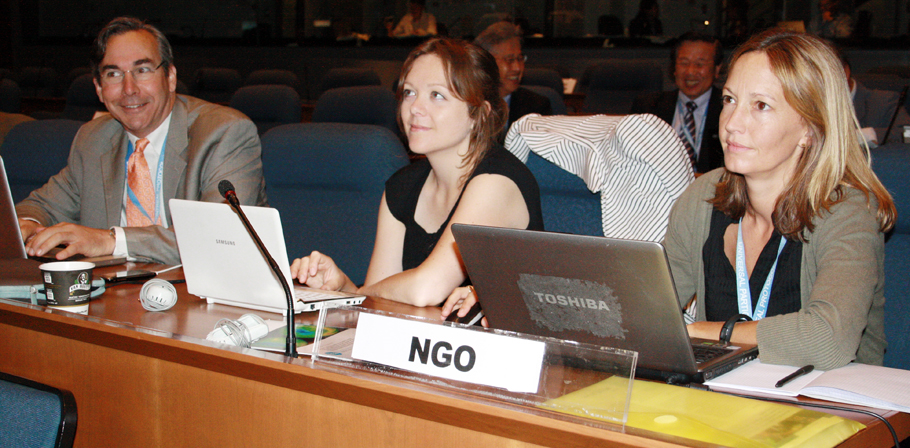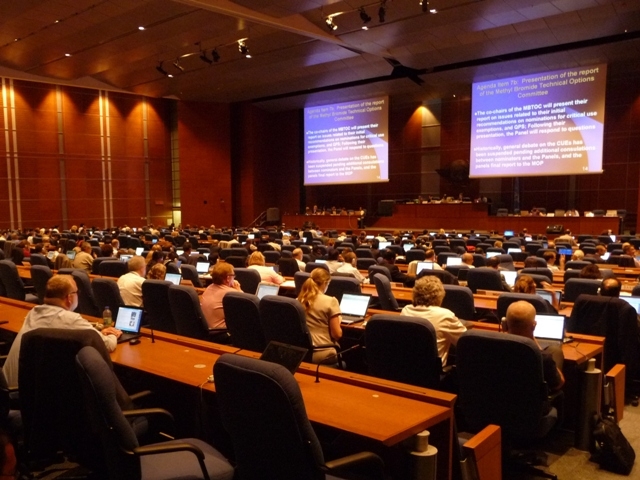Reporting live from the 31st OEWG of the Montreal Protocol
Day 5
It’s the last day of the OEWG and time to take a step back and see what we’ve achieved.
 The EIA team hard at work, do we look like we’re posing? Courtesy of IISD.
The EIA team hard at work, do we look like we’re posing? Courtesy of IISD.
Many aspects of the negotiations here have been frustrating, and it’s hard not to feel depressed that while India and China are digging their heels in over the HFC phase-down proposals, HFC use in developing countries is skyrocketing. According to the Scientific Assessment Report presentation yesterday by Professor Ravishankara, HFC emissions could represent up to 20% of all greenhouse gas emissions by 2050 and these proposals could save tens of gigatonnes of CO2-equivalent emissions over the coming decades. With frequent warnings that we are heading towards a climatic tipping point, you would have thought that initiatives like these would be welcomed with open arms.
However, while someone I spoke to yesterday qualified progress at these talks as ‘glacial’, it would be wrong to suggest that nothing has moved forward at all. At various stages in the Plenary discussions, negotiators have remarked upon the relatively constructive spirit that has reigned here over the past week. And while some of the bigger developing (or in Montreal Protocol jargon ‘Article 5’) countries have been less than constructive, others such as Georgia have made repeated and energetic interventions supporting an HFC phase-down and acknowledging the intrinsic link between ozone depletion and climate change. The presence of a number of climate ministry representatives is the sign of a subtle but significant shift in attitudes, even among the more recalcitrant countries .
It’s surprising that the link between climate change and ozone depletion is the subject of so much controversy, given the plethora of scientific reports and assessments that have established this.
Having attended last year’s climate conference in Cancun, it’s been a bit surreal to sit here and listen to some delegations defending the UNFCCC and its Kyoto Protocol so forcefully – I’m sure I’m not alone in thinking that it would be nice to see that enthusiasm translate to the climate negotiations. With the next Montreal Protocol meeting taking place just prior to the Durban climate talks no one is expecting any ground-breaking progress this year, but we will be looking to the 25th anniversary meeting of the Montreal Protocol in 2012 to see if it really deserves the accolade of the world’s most successful environmental treaty.
For a more detailed report of the proceedings here at OEWG 31, take a look at the IISD website. And just because in the midst of so much serious debate, it’s important to have a bit of light relief, here’s an example of the coffee art we were treated to every morning as we prepared the day ahead. Pas mal, as they say in Quebec.

(c) EIAimage
Coffee Dragon
***
Day 3
It would be nice to be able to report that negotiations are moving forward apace but, unfortunately, they’re not.
This morning, we sat through another lengthy discussion about the proposals put forward by the North America countries and Micronesia to phase out HFCs. While supportive delegations such as the EU agreed with the US that a phase-out is a moral imperative and argued that it would help drive technical innovation, China and India spent the entire session playing semantic ping-pong.
Arguments of varying degrees of sophistication were trotted out to demonstrate that the Montreal Protocol is not the forum to deal with an HFC phase-out, because there is no legal footing for it to do so (a claim heavily contested by many Parties here); because it would undermine the UNFCCC and the Kyoto Protocol (!), or because not enough scientific research has been carried out into alternatives to HFCs (it’s worth noting that both China and India blocked subsequent attempts to remedy this).
What it all boils down to is protection of vested interests – both China and India are defending the commercial interests of their domestic F-gas industries (which, lest it be forgotten, have already earned hundreds of millions of euros for HFC-23 offsets under the UN’s Clean Development Mechanism – and, to a certain extent, political grandstanding and positioning for the global climate talks. It’s very frustrating to sit here and listen to the debate go around and around in circles when an HFC phase-out is clearly the most immediate and cost-effective prospect for combating climate change in the short-term.
Mealtimes here are very perfunctory – in fact, we haven’t sat down to a hot meal since Sunday – all the more so as food and drink are strictly forbidden in the meeting rooms (a rule enforced by zealous security guards on every corner). So, after a five-minute refuelling stop, we headed to a ‘side event’ (UN jargon for a short workshop) on the European Union’s F-gas Regulation. This was organised by the European Partnership for Energy and the Environment (EPEE), the rather misleading name of the European Heating Cooling and Refrigeration Industry’s trade association, based in Brussels.
At the event, EPEE representatives and the refrigerant manufacturer Daikin sang the praises of the F-Gas Regulation, which essentially relies on weak controls to prevent leakage during installation, operation and disposal of equipment. Quite apart from the consideration that taking a containment and recovery approach to HFCs (rather than mandating a phase out) is simply storing up trouble for the future, it’s pretty obvious that the F-Gas Regulation in its current form is simply unworkable. The fact is that, by the industry’s own admission, the Regulation is not being taken seriously.
We expect the F-gas industry to fight tooth and nail to prevent any ambitious changes to the Regulation, which is currently under discussion. As far as we’re concerned, supporting a global phase-down of HFCs in the Montreal Protocol – which the EU is doing very forcefully here – goes hand-in-hand with a convincing domestic policy on HFCs – which the EU does not yet have.
Natasha Hurley, Climate Campaigner
***
Day 2
The meeting resumed today with the US, Canada, Mexico and Micronesia responding to a number of questions on scientific, legal, financial and technological issues raised by Parties concerning their proposals to amend the Montreal Protocol to phase out HFCs.
After much debate, it was decided to resume the discussion in plenary session tomorrow and consider the establishment of an informal contact group at a later point. The proponents of the phase-out proposals expressed strong disappointment about the informal nature of the contact group – the proposal has been on the table for three years now but has been kicked into the long grass as many times. The informal nature of the contact group means its discussions will not be formally reported in the proceedings of the meeting, just one of the stalling tactics being employed by India, China and others who are opposing any HFC measures under the Montreal Protocol.
 During lunch, Greenpeace held a side-event to present a new paper on the benefits of basing policies on a 20-year global warming potential (GWP) measure, rather than the current standard of 100-year GWP. GWP measures the potency of a greenhouse gas over a specific period of time, relative to CO2, which has a GWP of one. So, for example, the GWP of HFC-134a (the most commonly used HFC) is 1,430 – so it is 1,430 times more potent than CO2. The GWP measure is independent of atmospheric concentration – so we’re not saying that HFC-134a is currently causing 1,430 times more global warming than CO2, but it would if it was present in the atmosphere at the same concentration.
During lunch, Greenpeace held a side-event to present a new paper on the benefits of basing policies on a 20-year global warming potential (GWP) measure, rather than the current standard of 100-year GWP. GWP measures the potency of a greenhouse gas over a specific period of time, relative to CO2, which has a GWP of one. So, for example, the GWP of HFC-134a (the most commonly used HFC) is 1,430 – so it is 1,430 times more potent than CO2. The GWP measure is independent of atmospheric concentration – so we’re not saying that HFC-134a is currently causing 1,430 times more global warming than CO2, but it would if it was present in the atmosphere at the same concentration.
The timescale, however, is important because while CO2 has an atmospheric lifetime of several centuries, most HFCs remain in the atmosphere for just 10-20 years. The average lifetime of the HFCs in use today is 21.7 years. This means that the 100-year GWP does not fairly reflect their potency, since it is spread out over 100 years, while in actuality all the damage is done while it is present in the atmosphere, which in the case of HFC-134a is 14 years. The 20-year GWP of HFC-134a is 3,380 – more than double its 100-year GWP.
Why is this important in the context of climate change? In 2009, NASA’s eminent climate scientist, Dr. James Hansen, warned that the “climate is nearing dangerous tipping points… ”. Tipping points are abrupt, non-linear, unpredictable changes – the point of no return where there will be little we can do to prevent catastrophic and irreversible climate change. We don’t know when this will happen but it could be reached within a few decades, so efforts to prevent short-term climate forcing are really important.
The best available prospect for mitigating climate change in the short-term is undoubtedly a phase-out of HFCs under the Montreal Protocol. Using 20-year GWPs shows clearly the massive climate impact of HFCs, and is also highly relevant in the context of the increasing use of so-called ‘moderate’ GWP HFCs, such as HFC-32. Daikin and Panasonic are describing their new HFC-32 air conditioning technology as ‘climate-friendly’, as the GWP of HFC-32 is 675, significantly less than the most commonly used HFC. But over a 20-year period, HFC-32 has a GWP of 2,330 – how can this be climate-friendly?
Clare Perry. Climate Campaign Leader
***
Day 1 – 1st August 2011: Probably the first thing that you might notice if you have looked at our recent reports to the Montreal Protocol (which was set up to repair the ozone hole) is that we seem to talk a lot more about climate change than ozone depletion.
This is not because the ozone hole has been fixed – quite the reverse – 2011 saw the largest ever ozone hole in the Arctic and unfortunately while the Montreal Protocol has been successful in phasing out 98% of the consumption ozone depleting substances, and atmospheric levels of key ozone depleting substances are going down, it will take until the middle of the century for the ozone layer to return to pre-1980 levels.
But CFCs and HCFCs (the main ozone depleting chemicals) are also super greenhouse gases. We say ‘super’ because they are literally thousands of times more potent global warming gases than carbon dioxide. Because of this, the Montreal Protocol has already had a major impact on reducing greenhouse gas emissions and has been described as the best climate treaty to date (of course it doesn’t have much competition….).
CFCs and HCFCs are man-made chemicals used predominantly in refrigeration, air-conditioning, and as foam blowing agents, fire suppressants and aerosols. Countries converting from these chemicals have traditionally chosen hydrofluorocarbons (HFCs), chemicals that do not harm the ozone layer but that are super greenhouse gases with global warming potentials (GWP) hundreds to thousand of times greater than CO2. Developed countries that have already phased out ozone depleting substances have switched to high-GWP alternatives in around 75% of cases.
Fortunately there are substitutes available – so called natural refrigerants such as hydrocarbons – which are both climate and ozone friendly. So for the last few years our focus at the Montreal Protocol has been to urge Parties to phase out existing HFCs, and ensure that the ongoing developing country phase-out of HCFCs does not result in a massive phase-in of HFCs.
 Today’s meeting opened with Mr Marco Gonzalez, Executive Secretary of the Ozone Secretariat, setting out some of the highlights of the work carried out so far and the challenges ahead. There was then a presentation from the TEAP (Technical and Economic Assessment Panel) of a report which assessed the need for financing over the next three years to allow the continued phase-out of HCFCs in developing countries. A large number of questions were raised regarding the information in the TEAP report and a contact group was set up to further look at the information needed from the TEAP before the Meeting of the Parties in November when a decision on funding will have to be taken.
Today’s meeting opened with Mr Marco Gonzalez, Executive Secretary of the Ozone Secretariat, setting out some of the highlights of the work carried out so far and the challenges ahead. There was then a presentation from the TEAP (Technical and Economic Assessment Panel) of a report which assessed the need for financing over the next three years to allow the continued phase-out of HCFCs in developing countries. A large number of questions were raised regarding the information in the TEAP report and a contact group was set up to further look at the information needed from the TEAP before the Meeting of the Parties in November when a decision on funding will have to be taken.
The second substantive item on the agenda was proposals to phase down HFCs – one by the North American countries (US, Canada and Mexico) and another by Micronesia. Slightly different versions of the proposals have been submitted previously, for the first time in 2009. John Thompson from the US introduced the North American proposal describing the growth in HFCs as “…an impending crisis”, and noted that the longer we wait to address it, the more difficult and expensive this problem will be for all countries to take on. There followed a two and half hour discussion with many countries supporting the amendment proposals and the need for a contact group to discuss the proposals further. However several countries, most strongly India, China and Brazil, maintained that discussion of HFCs should remain under the UNFCCC as HFCs are not ozone depleting substances.
India repeatedly stated that they had questions about the proposals that had not been answered – and yet they would not support the idea of going into a contact group (a discussion group outside the main plenary part of the meeting), which is the usual process of the Montreal Protocol.
The European Commission reminded Parties that the BASIC countries (Brazil, S. Africa, India and China) had concluded at a meeting in February this year that the issue of the phase down high-GWP HFCs required an in-depth examination – he hoped that could start this week.
Georgia was brief but eloquent, stating that the possibility of HFCs being regulated under the climate regime is “zero” and that the only proposed way to prevent unconstrained growth of HFCs is the Montreal Protocol.
The meeting was adjourned without closing the agenda item – its clear there will be no resolution of this at this meeting, but at least some discussion is taking place.
